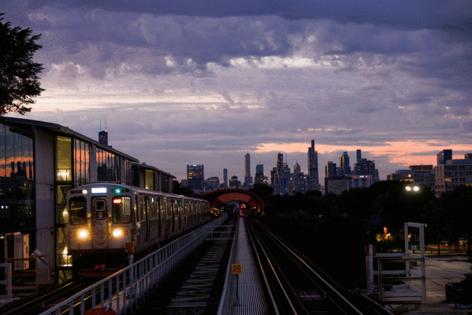Parking minimums eliminated in much of Chicago, change aimed at adding housing density
Published in Home and Consumer News
In what proponents say is a pivotal change to how housing gets built in much of Chicago, developers will now have the easy option to dedicate less space to cars after the City Council eliminated parking minimums near public transit.
Builders putting residences within a half mile of a Chicago Transit Authority train or within a quarter mile of a bus line will soon no longer need special approval to completely forgo parking spaces. Following the mid-July vote, the new standard appears to cover roughly three-quarters of the city.
The switch passed quickly, without pushback, when it came up in the Zoning Committee and again a day later in the full council. But mayoral critics, progressive aldermen, transit activists and developers alike said the quiet assent belies the policy’s impact.
“It makes it easier to build. It makes it more affordable to build,” lead sponsor Ald. Daniel La Spata, 1st, told the Tribune after the vote. “It gives much more flexibility to developers to add parking in ways that are meeting the market.”
By cutting mandates for expensive-to-build parking, the change will help more development “pencil out” and move ahead, said Sam Goldman, principal at real estate development and management firm Arbor Investment Management LLC.
“I think it’s an opportunity to start opening some of the doors to new construction,” Goldman said. “It makes more projects viable, especially in the neighborhoods.”
Developers in some areas were already able to eschew required parking with an administrative adjustment. La Spata’s ordinance extended the offer to all transit-served parts of the city outside of downtown — notably including residential neighborhoods — and dropped the need for special permission for reductions to otherwise required parking greater than 50%.
Mayor Brandon Johnson, who backed the change, said the measure is among his administration’s biggest moves yet to cut red tape restricting construction.
“This is basic economics 101. If the supply is less and the demand is great, it drives up pricing,” said Johnson, who has recently zeroed in on housing as a key focus. “It’s about building more affordable units. This is going to give us an opportunity to do that.”
The move won praise from some of Johnson’s staunchest critics, including the libertarian think tank Illinois Policy Institute. Eliminating parking minimums is a “pro-growth” move that “crosses ideological lines,” said Austin Berg, executive director of the institute’s Chicago Policy Center.
“It’s probably the single biggest free lever you can pull to increase the number of housing units in desirable neighborhoods in Chicago,” Berg said.
Berg criticized the city’s former “one-size-fits-all” system. Builders will now be able to tailor new construction to future occupants, he said. And developers will respond again, without a government mandate, if there isn’t enough parking, he added.
“If it’s profitable to build private parking, that’s something that will be built,” Berg said. “What you don’t want is the city government saying, ‘No matter what tenants of this building might want, you have to build a parking space for them.’”
The “huge deal” change is a response to the many modes of transportation Chicagoans now have access to, said Kyle Lucas, executive director of the transportation advocacy group Better Streets Chicago.
“Those parking minimums have just really jacked up the cost of building new housing in Chicago,” he said. “It’s an archaic way of approaching things.”
Co-sponsor Ald. Andre Vasquez said the new rules will add “soft density” to neighborhood buildings. The extra homes put into buildings in place of parking will help more projects meet the city’s affordability rules, he predicted.
“It’s not adding multiple floors on a project more than adding more units,” Vasquez said. “The difference between 10 and 14 units is big, especially when you’re thinking about the Affordable Requirements Ordinance.”
Andy Ahitow, managing principal at real estate firm CityPads, had a more measured forecast of the ordinance’s impact. He expects the change will lead to only limited new housing and primarily affect already-dense residential areas.
“It’s a very small step in the right direction,” Ahitow said. “It is helpful. It is positive. It’s not really solving our housing crisis.”
City Hall could do far more to spur development by more directly driving down construction costs, he argued. He called on Johnson’s administration to raise the unit threshold that triggers the complicated “planned development” approval process, allow for taller wood-frame buildings, weigh tax abatements for new construction and let four-story buildings be built without elevators.
La Spata’s ordinance also clears the way for developers to more easily access bonuses that allow them to build taller and more dense buildings if they make 20% of their units affordable, as determined by city rules.
The ordinance passed with zero fanfare just as other Johnson-backed moves to add housing density failed to advance.
In the same meeting, the mayor’s team had hoped to pass an ordinance allowing homeowners to build “additional dwelling units” across the city. The measure’s opponents use a parliamentary maneuver to stall a vote, citing fears the policy would dramatically change their single-family-home neighborhoods.
Johnson’s administration had already called off a planned vote on a plan to upzone a large stretch of North Broadway. Before the delay, activists fighting the measure warned they would sue the city over an alleged failure to give Edgewater residents proper notice of the proposed change.
But Johnson nonetheless vowed last week to move ahead on the efforts he believes will lead to more affordable housing across the city.
He compared his past approach to a traditional football offense, but said he wants to use more aggressive tactics now, “more of a trips right, shotgun, hurry-up.”
“We’re on pace to build at least 10,000 units by the end of my first term,” Johnson said. “We’re going to work to expedite that.”
©2025 Chicago Tribune. Visit at chicagotribune.com. Distributed by Tribune Content Agency, LLC.








Comments